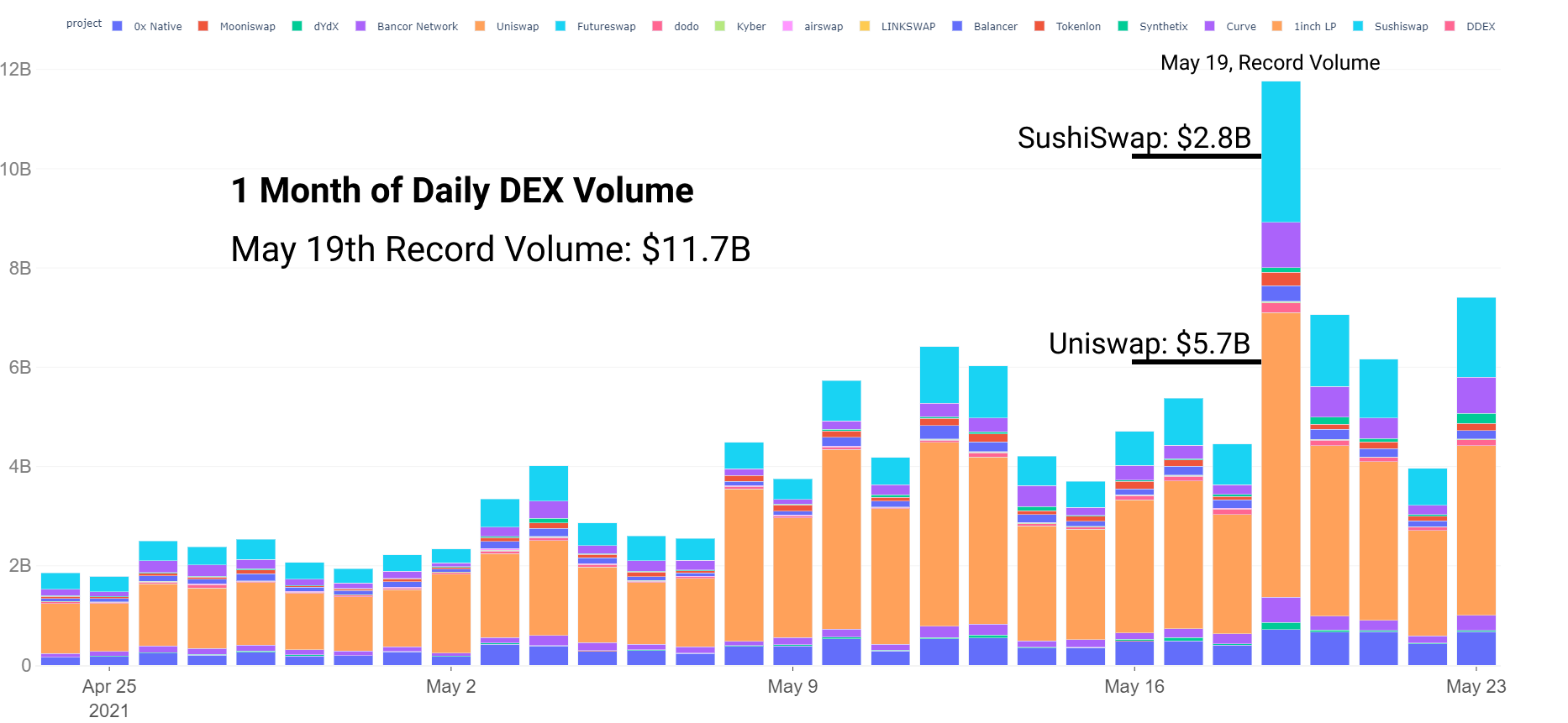Analyst says DeFi and stablecoins held up well as crypto markets imploded
The decentralized finance (DeFi) sector faced its first real challenge during last week'south marketplace sell-off that saw more than $i trillion wiped from the global cryptocurrency market cap every bit traders feverishly ran for the rubber of stablecoins amid tumbling prices.
Despite apace declining token prices, the nascent DeFi sector held its ain as decentralized exchanges experienced a tape $11.7 billion in trading volume on May xix. Uniswap (UNI) led with $5.7 billion in volume, followed by SushiSwap (SUSHI) which saw $2.8 billion in 24-hr trading volume.

Co-ordinate to the recent DeFi Uncovered report from Glassnode, baddest DeFi tokens including, UNI, SUSHI, Maker (MKR), Aave (AAVE) and Compound (COMP) have largely mirrored the decline of Ether (ETH) over the past two weeks, "showing relatively high beta to ETH merely non exceeding the decline from ATH by more 15% from the decline of ETH."
New users increase despite declining TVL
The pullback in prices, combined with users removing liquidity and rotating into stablecoins led to a 42% decline in the total value locked on smart contracts, which also closely tracked the falling price of Ether.

TVL is intrinsically tied to the underlying value of the deposited tokens and given that Ether is one of the main tokens locked beyond DeFi platforms, the falling TVL has less to practice with users removing funds and is mostly related to the pullback in prices.
Throughout last week'south downturn, the percentage of the Ethereum supply locked in smart contracts remained above 23% while the supply on exchanges "jumped from xi.13% to xi.75%."
Despite falling prices, new users proceed to enter the DeFi ecosystem and the total number of unique 30-twenty-four hour period traders on the top DEXs surpassed the 1 1000000 marker for the first time amid last week's sell-off.

Uniswap is the clear leader with 815,000 unique users between April 24 to May 23, while 1inch (1INCH) came second with 78,200 users and SUSHI ranked tertiary with 10,900 users.
Stablecoins hold their pegs
Much of the force seen in DeFi during the sell-off tin be attributed to the good for you stablecoin market and the ability for major stablecoins like USD Coin (USDC), Tether (USDT) and Dai (DAI) to maintain their dollar peg "for the majority of the crash with book-weighted average prices (VWAP) staying at $ane.00 the majority of the time."

The functioning of DAI was seen every bit "peculiarly positive for DeFi" according to Glassnode, as its circulating supply was able to adjust accordingly in response to collateral requirements and protocol stability. The study also highlighted that reclaimed collateral and DAI were removed from the supply equally redemptions were claimed by collateral holders.
Posey said:
"This behavior allows collateral to stay healthy, liquidations remain at a healthy level, and DAI to maintain its peg."
The i stablecoin that struggled to maintain its peg was TerraUSD (UST), which lost its peg on May 18 as the value of its collateral from LUNA fell beneath that of the stablecoin information technology collateralized. This led to "unhealthy behavior in its lending market place Ballast (ANC)," causing a higher than boilerplate number of liquidations on the protocol'southward native lending platform.
Overall, stablecoins performed their intended office and pegs held steady across the ecosystem with the on-chain stablecoin transfer volume reaching a record $52 billion during the height of the sell-off.
The views and opinions expressed here are solely those of the author and do not necessarily reflect the views of Cointelegraph.com. Every investment and trading movement involves gamble, you should bear your own research when making a decision.
Source: https://cointelegraph.com/news/analyst-says-defi-and-stablecoins-held-up-well-as-crypto-markets-imploded
Posted by: mazurfident75.blogspot.com


0 Response to "Analyst says DeFi and stablecoins held up well as crypto markets imploded"
Post a Comment